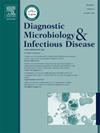Concurrent chromoblastomycosis and subcutaneous phaeohyphomycosis by different pathogens in a renal transplant recipient
IF 2.1
4区 医学
Q3 INFECTIOUS DISEASES
Diagnostic microbiology and infectious disease
Pub Date : 2025-06-06
DOI:10.1016/j.diagmicrobio.2025.116945
引用次数: 0
Abstract
Chromoblastomycosis and subcutaneous phaeohyphomycosis are implantation mycoses caused by melanized fungi. We present a unique case of concurrent chromoblastomycosis by Fonsecaea monophora and phaeohyphomycosis by Medicopsis romeroi presenting as polypoidal wrist lesion and painless cystic toe lesion respectively in a renal transplant recipient. The diagnosis was confirmed by microbiological (including molecular identification by sequencing of ITS region of rDNA) and histopathological examination. The wrist lesion was surgically excised. Oral itraconazole and topical luliconazole led to healing of both lesions within six months of therapy. This case highlights the emergence of rare opportunistic fungal pathogens causing concurrent skin infections in an immunocompromised patient. This warrants investigation of their epidemiology and virulence to implement preventive measures in renal transplant recipients.
肾移植受者不同病原菌并发的成色菌病和皮下褐丝菌病
成色菌病和皮下褐丝菌病是由黑化真菌引起的植入性真菌病。我们报告了一例肾移植受者并发的单色菌病和绿脓杆菌病,分别表现为息肉状手腕病变和无痛性囊性脚趾病变。经微生物学(包括rDNA ITS区测序的分子鉴定)和组织病理学检查证实诊断。手术切除了手腕病变。口服伊曲康唑和外用吕立康唑可使两种病变在治疗6个月内愈合。本病例强调了罕见的机会性真菌病原体的出现,导致免疫功能低下患者并发皮肤感染。这需要对其流行病学和毒力进行调查,以便在肾移植受者中实施预防措施。
本文章由计算机程序翻译,如有差异,请以英文原文为准。
求助全文
约1分钟内获得全文
求助全文
来源期刊
CiteScore
5.30
自引率
3.40%
发文量
149
审稿时长
56 days
期刊介绍:
Diagnostic Microbiology and Infectious Disease keeps you informed of the latest developments in clinical microbiology and the diagnosis and treatment of infectious diseases. Packed with rigorously peer-reviewed articles and studies in bacteriology, immunology, immunoserology, infectious diseases, mycology, parasitology, and virology, the journal examines new procedures, unusual cases, controversial issues, and important new literature. Diagnostic Microbiology and Infectious Disease distinguished independent editorial board, consisting of experts from many medical specialties, ensures you extensive and authoritative coverage.

 求助内容:
求助内容: 应助结果提醒方式:
应助结果提醒方式:


